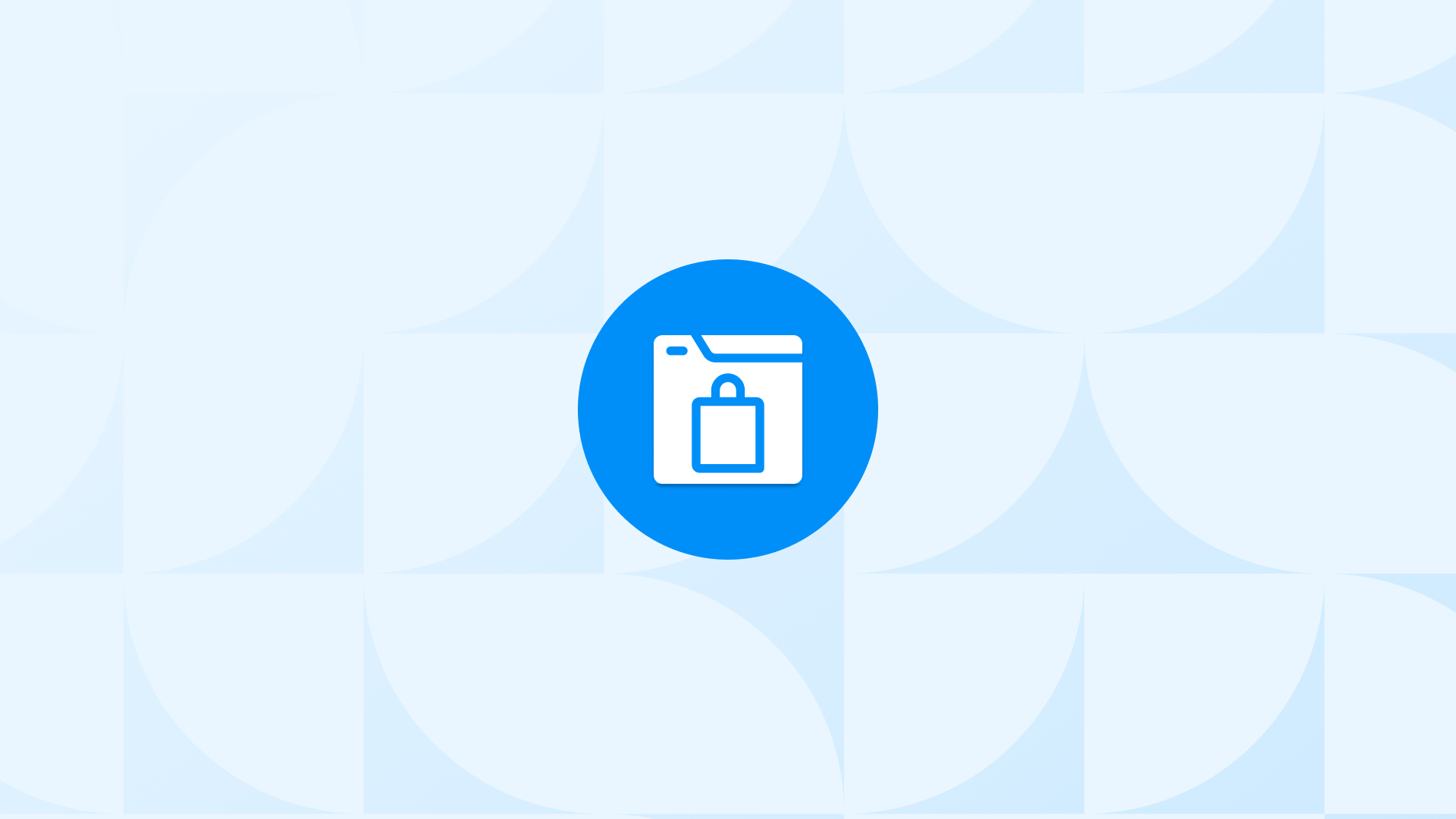Shopify pricing has changed, and so has what each Shopify plan includes.
In 2025, choosing between different Shopify Plans isn’t just about cost.
It’s about understanding which features are included, which are missing, and when a cheaper Shopify plan starts limiting your business.
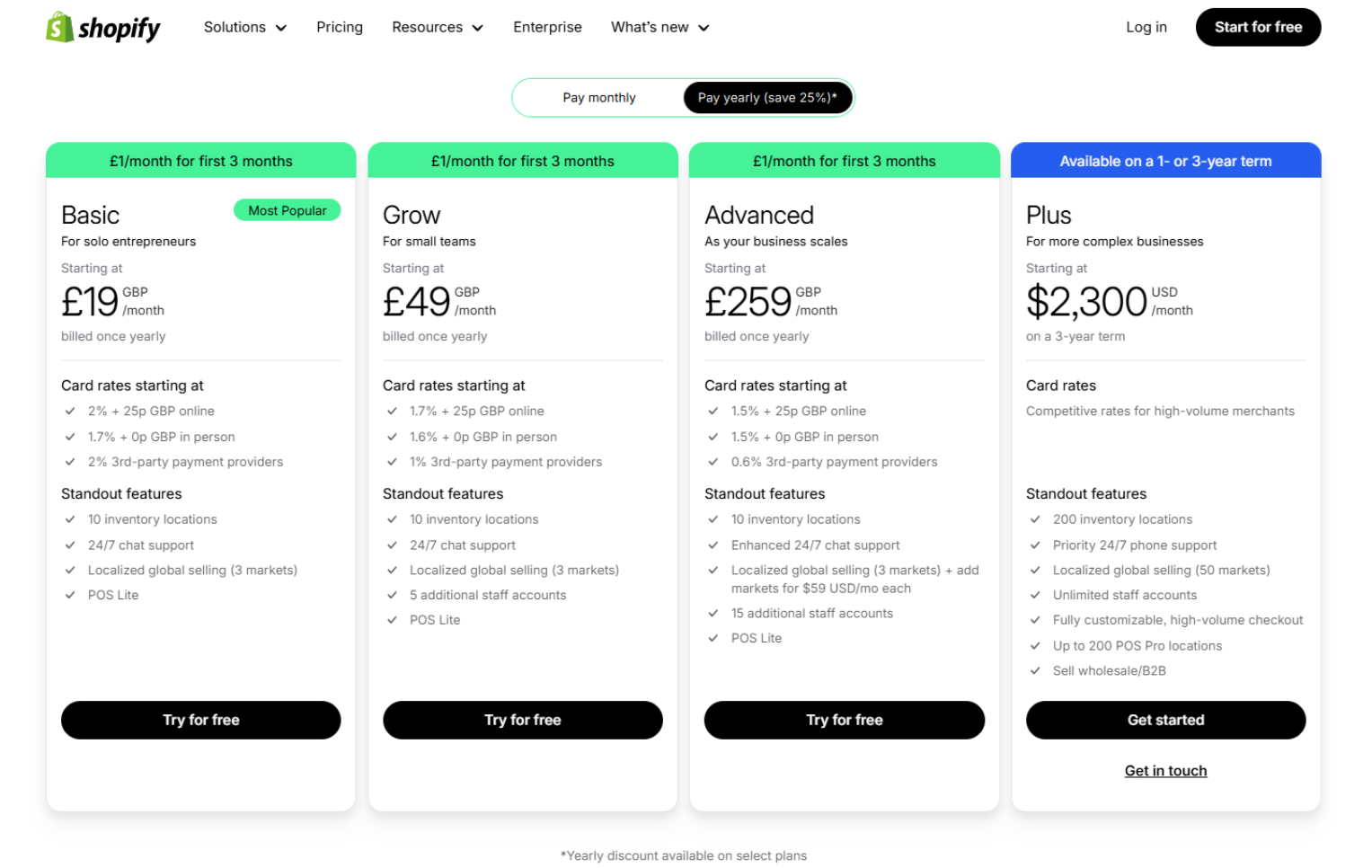
This guide will walk you through all Shopify Plans in 2025, from the most basic to the most advanced.
You’ll see what each Shopify plan offers, where the limitations are, and when it makes sense to move to a higher tier based on team size, sales volume, or international needs.
Let’s get started!
Bonus Content: Shopify vs Shopify Plus—what’s the difference? Choosing Between Shopify and Shopify Plus: Features and Cost explains it.
Comparing The Features Of Shopify Plans (2025)
At a glance, many Shopify Plans look similar. All of them offer unlimited products, access to sales channels, and storefront tools.
But the key differences show up in operational limits, fees, and what you’re forced to pay extra for.
Here’s a detailed comparison table of the all available Shopify Plans in 2025:
| Feature | Starter | Basic | Grow | Advanced | Plus |
|---|---|---|---|---|---|
| Monthly Price (USD) | $5/month | $39/month | $105/month | $399/month | $2,300-$2,500/month |
| Staff Accounts | 0 | 0 | 5 | 15 | Unlimited |
| Apps Support | No | Yes | Yes | Yes | Yes |
| Custom Reports | No | No | No | Yes | Yes |
| Checkout Customization | No | No | No | No | Yes |
| Third-Party Payment Fee | Required (5%) | 2% | 1% | 0.5% | 0% |
| POS Pro Access | Not supported | Optional | Optional | Optional | 20 locations free |
| Shipping Discounts | Low | Up to 77% | Up to 88% | Up to 88% | Highest available |
| International Pricing Tools | No | Basic | Basic | Advanced | Full |
| Multi-Store Support | No | No | No | No | Up to 10 stores |
| B2B Features | No | No | No | No | Yes |
Use this as a quick reference while comparing different Shopify Plans in 2025.
For a detailed breakdown of each Shopify Plan in 2025, we cover the pricing, unique benefits by business type, ideal use cases, and key limitations below:
Shopify Starter: Simple, But Extremely Limited
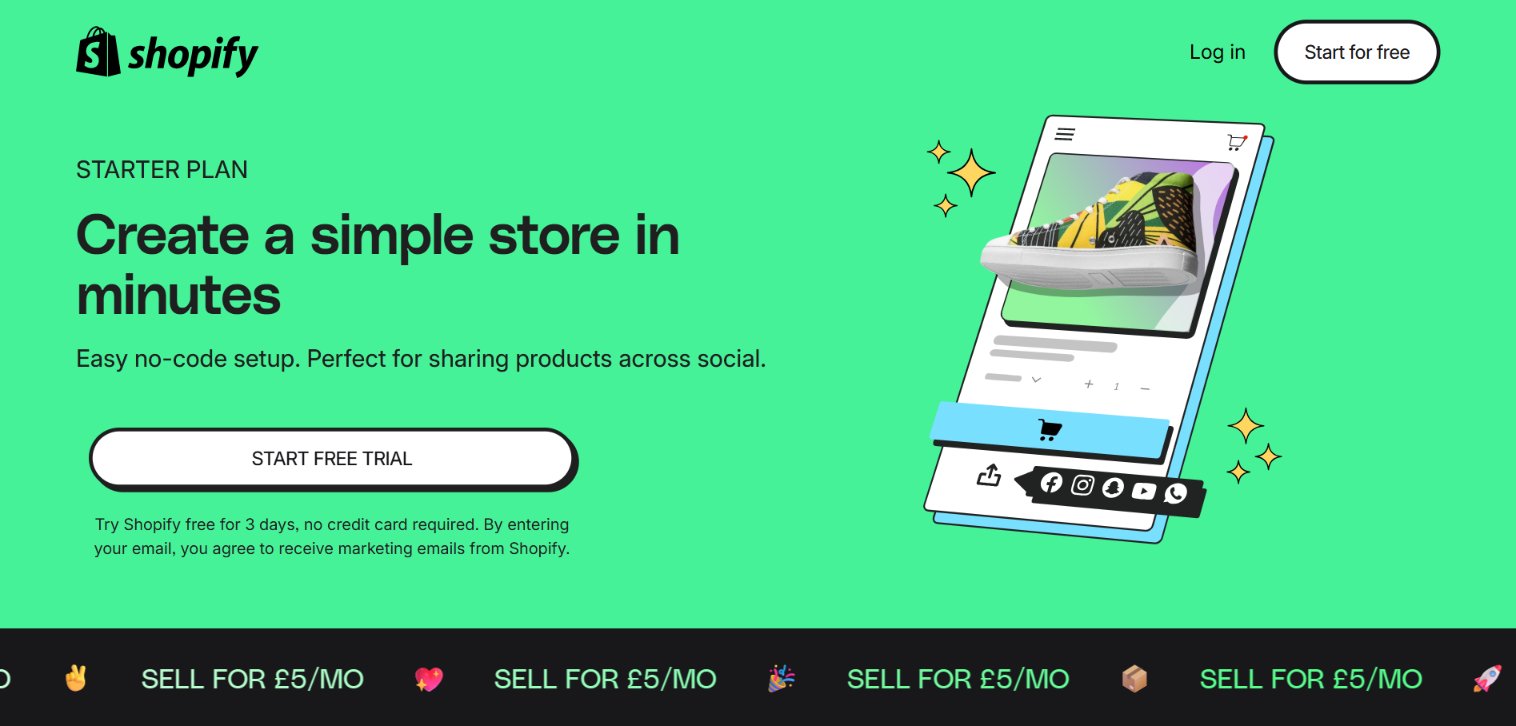
The Starter Plan is Shopify’s lowest-tier option.
It’s meant for creators or small sellers who want to take payments through social media, messaging apps, or a personal site, without building a full online store.
However, the limitations are immediate:
- You must use Shopify Payments. Third-party payment gateways aren’t supported.
- Transaction fees are high. You pay around 5% per order, which cuts into margins quickly.
- No app support. You can’t install any apps, which blocks even basic functionality like reviews or upsells.
- No staff access. Only the store owner can log in, no VA, no partner, no one else.
- POS can’t be upgraded. You’re locked into POS Lite with no way to access Pro features.
Suggested Use Case: The only thing you get with the Shopify Starter plan is a simple storefront, a buy button, and basic inventory/order tracking.
It works if you already have an audience and just need a way to collect payments.
But if you plan to grow, even slightly, you’ll hit the ceiling fast. Among all Shopify Plans in 2025, Starter has the most severe limitations. It’s a payment tool, not a store.
Bonus Content: Exploring custom storefront options? Read “What Is Headless Shopify and When Does It Make Sense?” to see if it fits your use case.
Shopify Basic Plan: Affordable Start
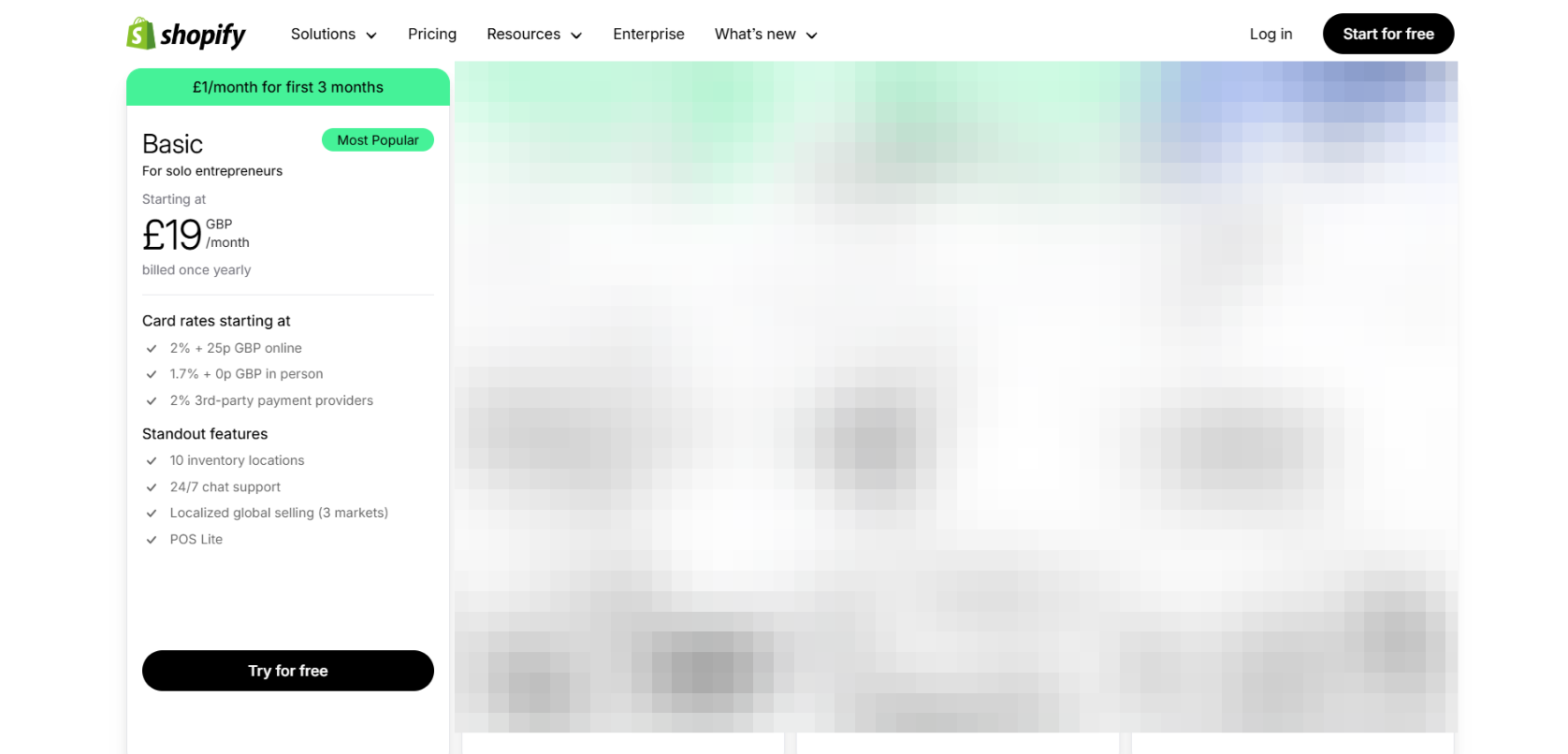
The Shopify Basic Plan used to be the go-to option for new stores.
It still offers the core tools you need to run a full online store, custom themes, product collections, marketing features, and basic reports.
But in 2025, it lost one critical feature:
- No staff accounts. You can’t add team members. Even a part-time assistant or co-founder can’t access the backend unless you upgrade.
- Payment processing fees are higher. You’ll pay more per order compared to higher Shopify plans, especially if you’re not using Shopify Payments.
- Limited international tools. You can sell in multiple currencies, but advanced features like country-specific pricing and duties require upgrading.
- Shipping discounts are weaker. You get up to 77% off, but Grow and Advanced Shopify plans offer better rates and options.
Despite these limits, Basic still includes:
- A full online storefront with theme customization
- Unlimited products and file storage
- Access to major sales channels (Instagram, Facebook, Amazon, etc.)
- Abandoned cart recovery
- Analytics dashboards and prebuilt reports
Suggested Use Case: If you’re running a one-person business and just getting started, the Shopify Basic Plan still works.
But if you plan to delegate work or scale operations, it won’t last long.
Among different Shopify Plans in 2025, Basic now serves more as a short-term entry point than a sustainable long-term solution.
Bonus Content: Discover real use cases of AI in ecommerce with “Shopify + ChatGPT: What to Know About AI-Powered Shopping.”
Shopify Grow Plan: The Starting Point for Most Businesses in 2025
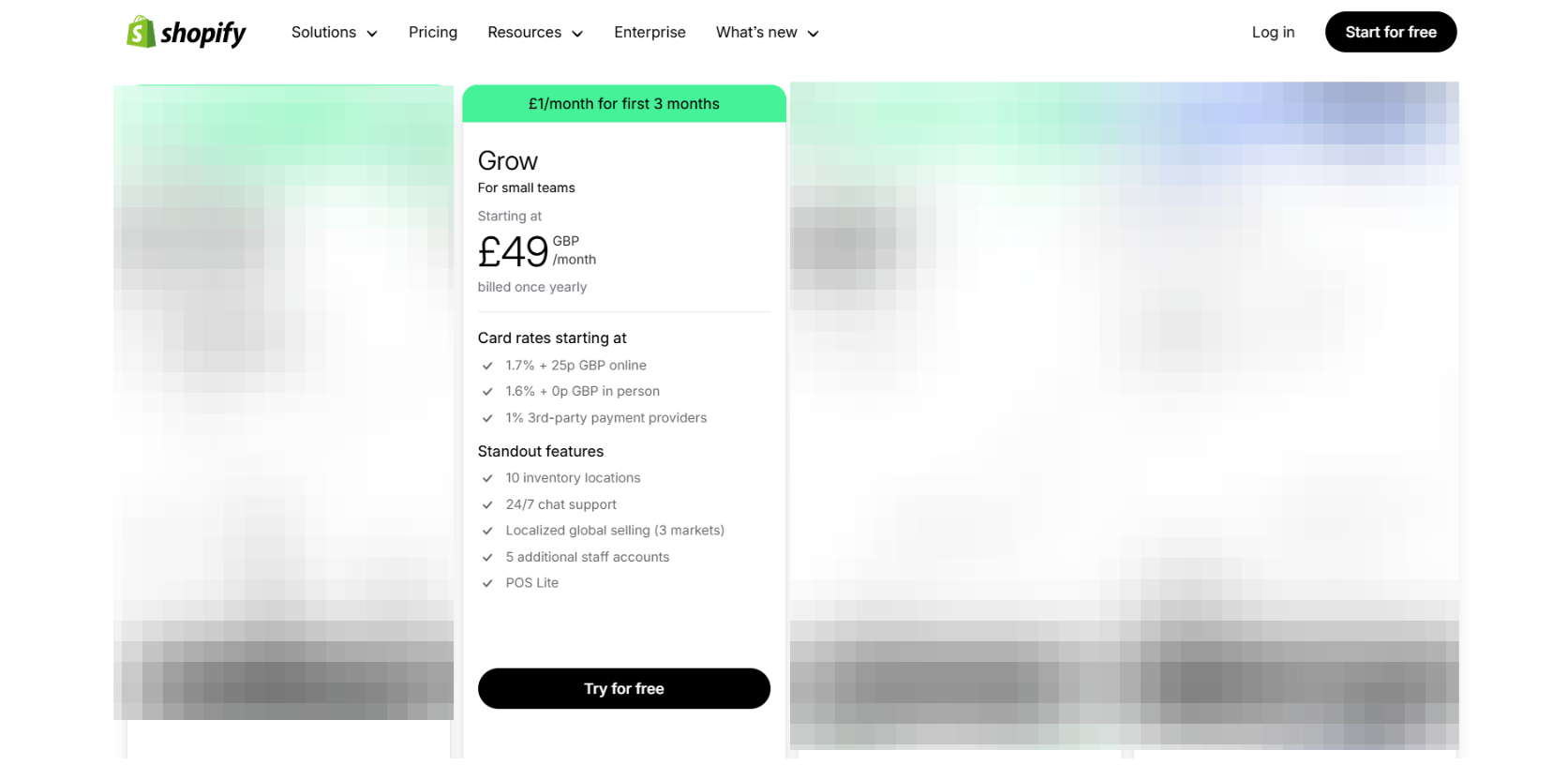
The Grow Plan (formerly called “Shopify”) is now the plan most small and mid-sized businesses actually need.
The feature set hasn’t changed much, but Shopify repositioned it to reflect the shift in how people use the platform.
Here’s what sets it apart:
- 5 staff accounts included. This is the first Shopify plan where you can properly run a team, no workarounds or shared logins.
- Lower transaction fees. Shopify Payments rates are better than Basic. If you’re processing steady sales, this adds up quickly.
- Better shipping rates. You get access to USPS Cubic pricing and up to 88% off standard shipping, which helps reduce fulfillment costs.
- Same storefront tools as Basic. You get full theme access, sales channels, abandoned cart recovery, and marketing features.
However, Grow still has some limits:
- No custom reports. You can view all standard reports, but you can’t build your own.
- No real-time shipping rates with external carriers. You’ll need the Shopify Advanced Plan for that.
- International pricing is basic. You can’t set country-specific prices or collect duties.
Suggested Use Case: If you’re comparing Shopify Plans in 2025 and wondering where to start for a serious store, Grow is the first plan that doesn’t block essential team or operational features.
For any business making consistent monthly revenue or managing a small staff, Basic will fall short. Grow is where running a store stops being a solo job.
Bonus Content: Looking to enhance your store’s performance? Explore our curated list of “Top Shopify Apps for Analytics, SEO, and Marketing (2025)” to find the best tools for your business.
Shopify Advanced Plan: High Cost, But Built for Complex Operations

The Shopify Advanced Plan is designed for stores with larger teams, international reach, or detailed reporting needs.
It’s a significant jump in price, but the added features are targeted at specific business problems, not just general upgrades.
Key advantages:
- 15 staff accounts. Enough to cover fulfillment, support, marketing, and finance teams.
- Custom reporting tools. You can create reports filtered by almost any metric, which is useful for tracking performance across SKUs, regions, or campaigns.
- Real-time shipping rates from external carriers. You can connect your own UPS or FedEx account and show live shipping costs at checkout.
- International selling tools. Set custom prices per country, include duties and taxes at checkout, and manage up to 50 markets (with add-ons).
Other benefits include:
- Lowest transaction fees among standard Shopify plans
- Access to all storefront features and integrations
- Same shipping discounts and USPS Cubic pricing as Grow
What’s not different:
- The core store setup is still the same. Theme options, product limits, and POS access don’t change.
- You still pay extra for POS Pro per location.
Suggested Use Case: Advanced becomes worth it when your business is already operating at a high volume, shipping internationally, or managing complex operations that require flexibility in pricing, reporting, or logistics.
If you’re comparing Shopify Plans in 2025 and wondering when to move up, Advanced usually makes sense when the saved fees and extra control outweigh the higher monthly cost.
Bonus Content: Get a detailed breakdown of logistics, pricing, and service levels in “Shopify Fulfillment Network: Costs, Features, and Alternatives (2025)”.
Shopify Plus Plan: Full Control
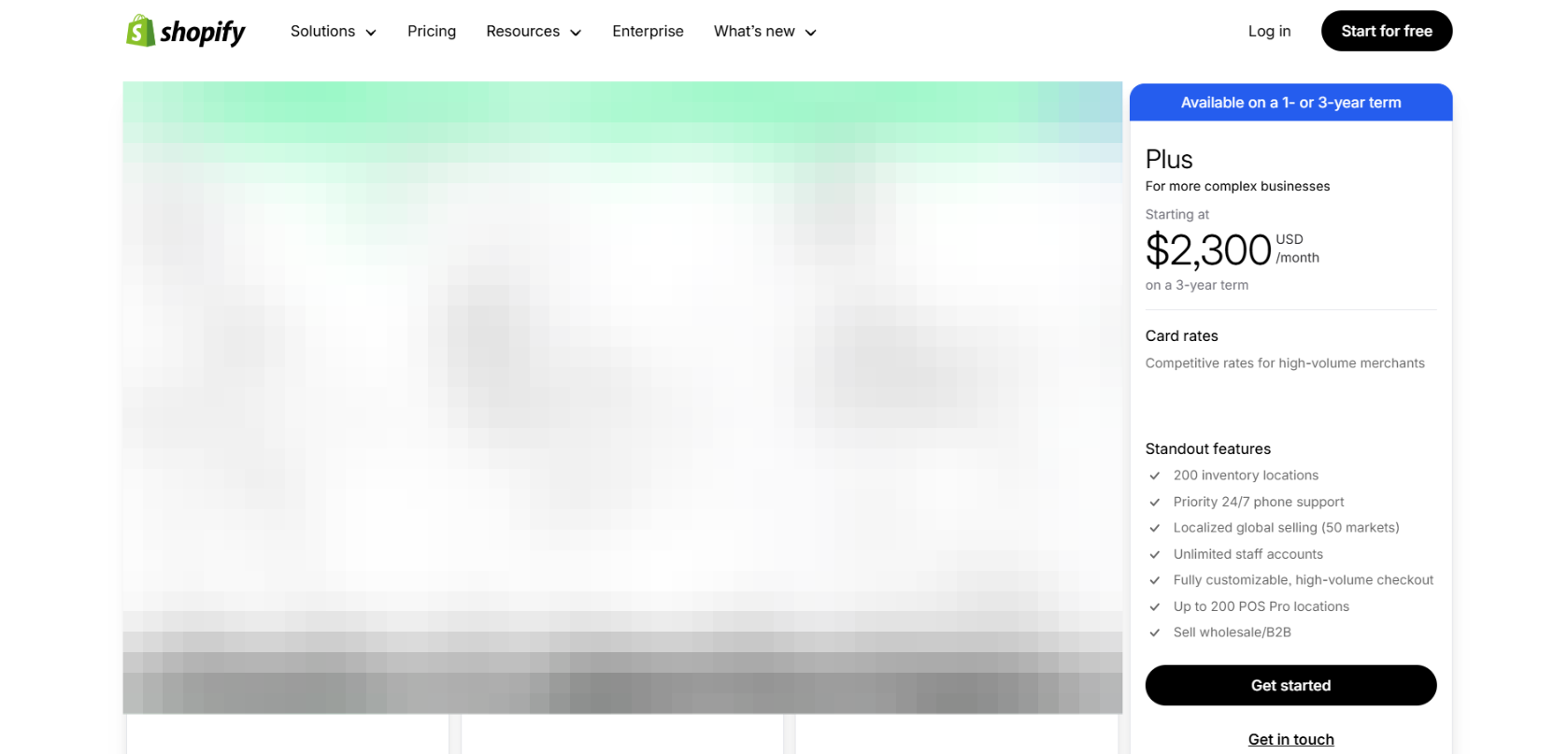
Shopify Plus is positioned for enterprise-level businesses, but not just by revenue.
It’s for brands that need control over checkout, complex operations, or dedicated support.
What it offers beyond Advanced:
- Unlimited staff accounts. No limits for teams, departments, or agencies.
- Full checkout customization. You can edit checkout logic, design, and behavior, something no other Shopify Plan allows.
- Up to 10 storefronts. Useful for managing separate brands, regions, or B2B vs B2C sites under one account.
- B2B features built-in. You can set custom price lists, payment terms, and company accounts without third-party apps.
- 20 POS Pro licenses included. If you run multiple retail stores, this saves thousands per year.
- Lower transaction fees. Rates are negotiable and significantly better than any other Shopify plan.
- Dedicated account manager. You get priority support and migration assistance.
Shopify Plus also removes transaction fees for external gateways, supports 200 inventory locations, and unlocks APIs and tools not available on standard Shopify plans.
However:
- The cost is high and requires a long-term commitment.
- You still rely on apps for some features, Plus doesn’t remove that need entirely.
- Customization requires developer help in most cases.
For most businesses, Plus only makes sense after you’ve outgrown every other plan.
Suggested Use Case: If you’re comparing Shopify Plans in 2025 and your team is already hitting Advanced limits, on reporting, staffing, or international storefronts, it may be time to move up.
At that point, Shopify Plus becomes a long-term infrastructure decision, not just a feature upgrade.
Read More: Take a closer look at advanced tools, support options, and infrastructure upgrades in our post “Exploring Shopify Plus Features in 2025.”
2025 Shopify Plan Updates You Should Know
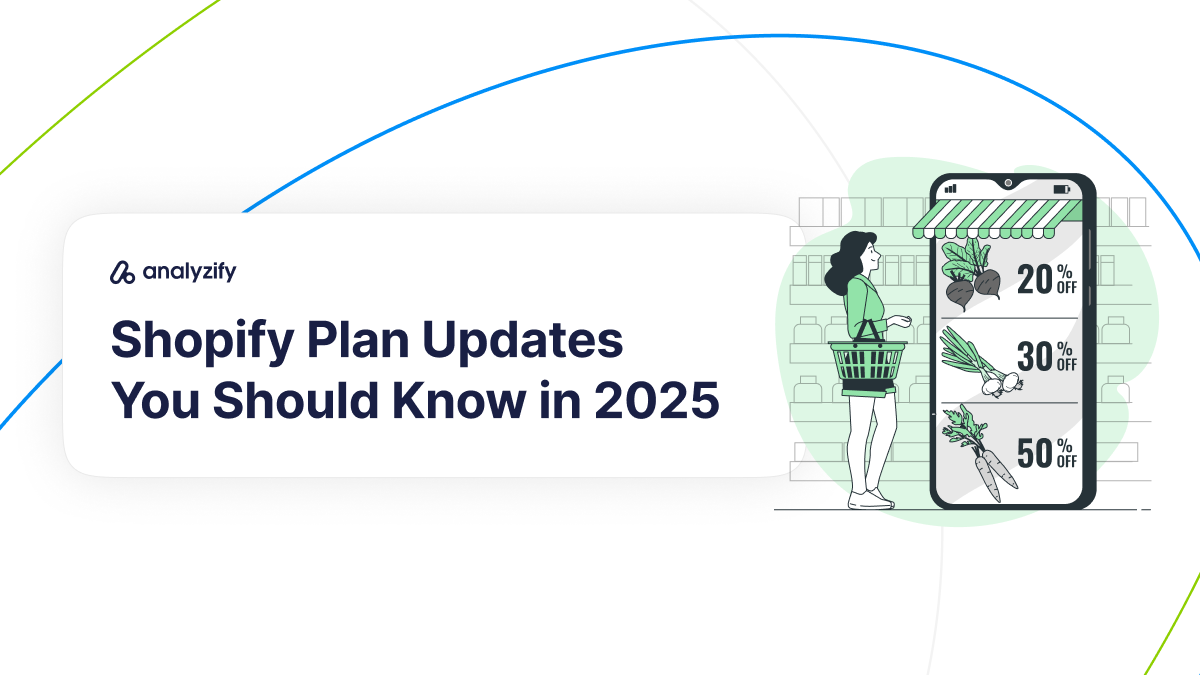
Before choosing between Shopify Plans in 2025, it’s also worth understanding how Shopify’s pricing and feature structure has shifted over time.
Here are the 2025 Shopify Plan updates that impact how each Shopify Plan works in practice:
- The Shopify Plan was renamed to Grow. The features are mostly the same, but the new name signals it’s meant for growing teams.
- Basic Plan no longer includes staff accounts. This change forces even small businesses to upgrade if they need help managing the store.
- Starter Plan replaced the old Lite Plan. It supports only Shopify Payments, has a high transaction fee, doesn’t allow apps, and blocks POS upgrades.
- Advanced Plan became more expensive. However, it didn’t receive major new features. It’s still positioned for businesses with global operations or reporting needs.
- Shopify Plus pricing increased. Long-term contracts are now required for lower rates. It remains the only plan offering checkout customization, B2B tools, and multi-store access.
These changes affect nearly all merchants comparing Shopify Plans in 2025, especially small and mid-sized businesses that relied on lower tiers in the past.
When to Upgrade Your Shopify Plan
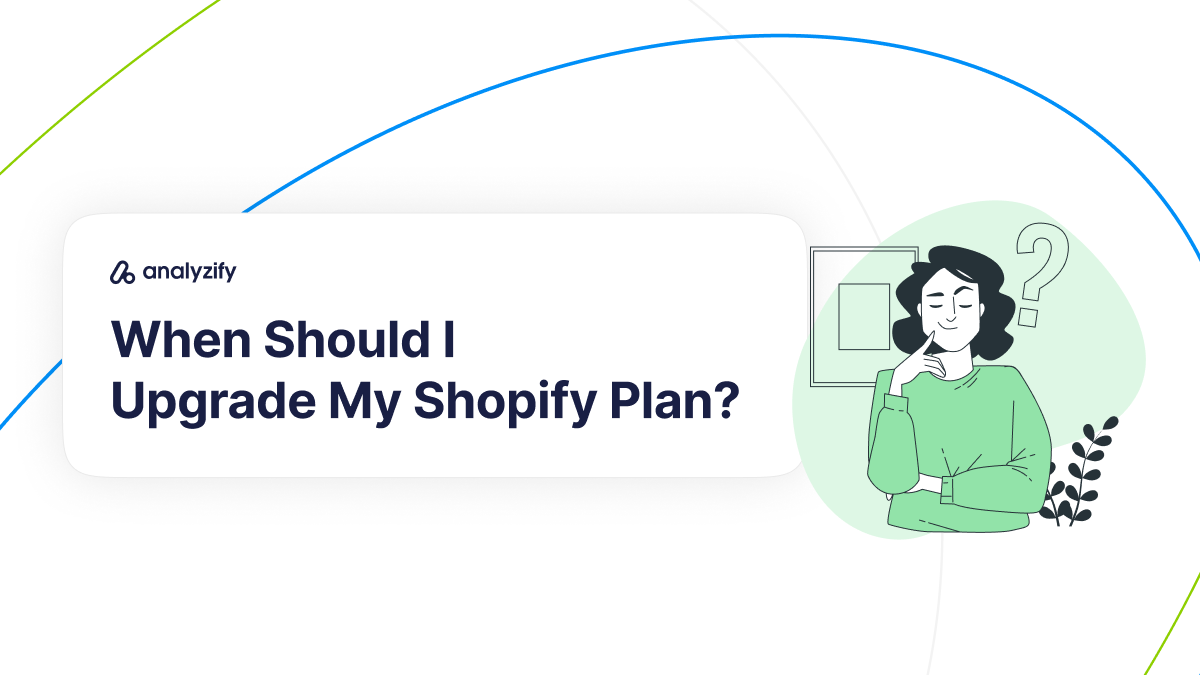
Most merchants don’t upgrade their Shopify plans because of features, they switch because something breaks or becomes a bottleneck.
Comparing Shopify Plans in 2025 is easier when you focus on these practical upgrade triggers:
- When you’re no longer working alone The Basic Shopify Plan doesn’t support staff accounts. If you need to share access with a VA, co-founder, or team member, you’ll need to upgrade to the Grow Shopify Plan, which includes 5 staff accounts. The Advanced Shopify Plan allows up to 15.
- When your monthly sales volume increases If you’re earning more than $10,000/month, transaction fees on the Basic or Grow Shopify Plan start to add up. Upgrading to a higher Shopify Plan reduces these fees and can save more than the plan’s monthly cost.
- When you’re selling in multiple countries If you need to adjust pricing by country or show duties and taxes at checkout, the Basic and Grow Shopify Plans won’t be enough. The Advanced Shopify Plan unlocks regional pricing and tax tools. Shopify Plus expands this further with support for 50 markets.
- When you’re relying on spreadsheets for insights If you’re constantly exporting sales data to analyze performance, your current Shopify Plan is likely holding you back. The Advanced Shopify Plan allows you to build custom reports directly in the admin, no more manual work.
- When you’re opening physical retail stores If you’re managing more than one location, the POS Pro fees on a Basic, Grow, or Advanced Shopify Plan will add up fast. Shopify Plus includes 20 POS Pro licenses, making it the only Shopify Plan designed for retail at scale.
- When you want control over the checkout process If you need to change the layout, add upsells, or introduce logic during checkout, no standard Shopify Plan will support it. Only Shopify Plus allows full checkout customization through Shopify Functions and Checkout Extensibility.
See how Shopify compares to its biggest rival in “Shopify vs WooCommerce: Which Is Better In 2025?”. We break down features, pricing, scalability, and real business use cases.
Hidden Costs in Different Shopify Plans in 2025
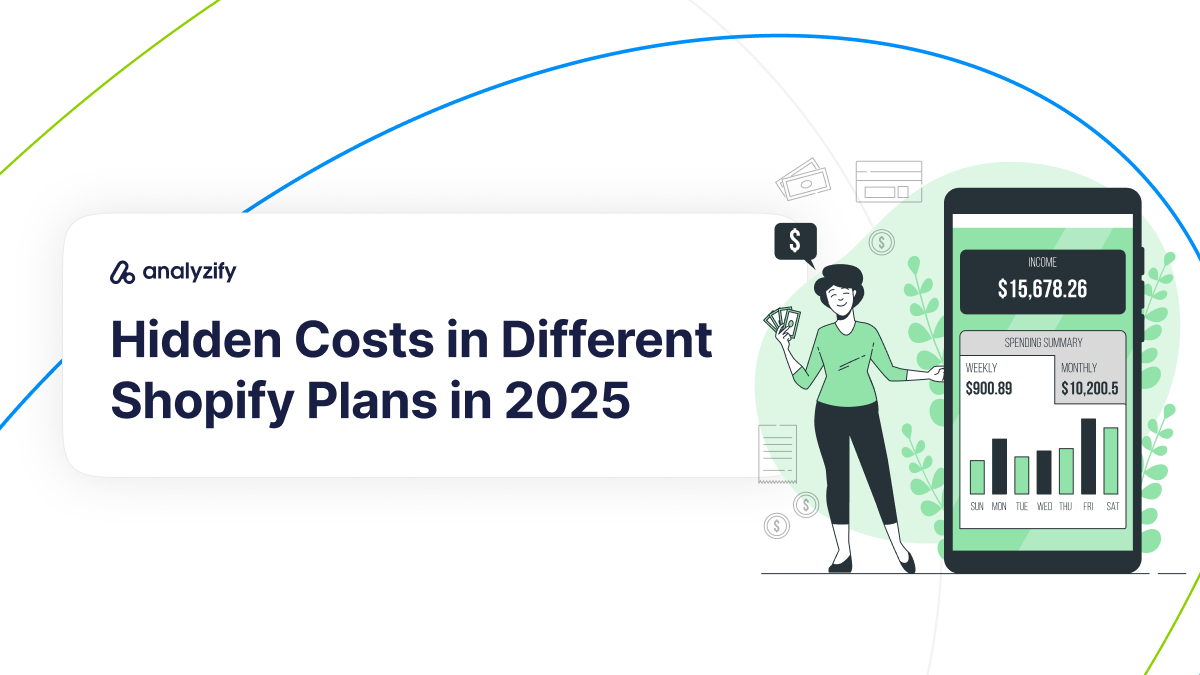
Shopify’s pricing looks simple, but the actual cost of running a store is often higher than expected.
Each Shopify Plan in 2025 comes with limitations that lead to extra spending, on apps, fees, or platform add-ons. Here’s what to watch for before choosing your plan.
- Paid apps will raise your monthly cost, especially on Starter and Basic These Shopify Plans don’t include many built-in tools. You’ll often need apps for product reviews, upsells, shipping rules, analytics, or even basic automation. Most paid apps cost between $10–$30/month. Using just 3–5 apps can add $50–$150 to your monthly bill.
- Not using Shopify Payments adds platform fees If you choose a third-party gateway like Stripe or PayPal, Shopify adds its own fee on top. Basic charges 2% per transaction, Grow charges 1%, Advanced charges 0.5%. Shopify Plus removes this fee entirely. At scale, these fees can cost more than the plan itself.
- POS Pro adds $89/month per store, unless you’re on Plus
If you run a physical store and want to use Shopify’s full POS system, it’s not free. POS Pro is $89/month for each retail location. Shopify Plus includes 20 POS Pro licenses, which saves over $1,700/month compared to other plans. - Some apps charge more as your store grows
Many apps don’t have flat pricing. They charge based on your Shopify Plan, order volume, or revenue. When you upgrade to Grow or Advanced, some apps automatically move you to a higher billing tier without adding more features. - Monthly billing costs more than annual billing If you pay month-to-month, you’re paying the highest price. Shopify offers 20–25% discounts on annual plans. For example, the Basic Shopify Plan drops from $39/month to ~$29/month when paid yearly. If you plan to stay on a plan for more than a few months, annual billing saves money.
These added costs don’t appear on the Shopify pricing page, but they affect your bottom line.
When comparing Shopify Plans in 2025, it’s important to factor them in from the start.
Conclusion: Which Shopify Plan Should You Use in 2025?
There’s no perfect Shopify plan for everyone, but there is a clear path based on how your business operates.
Here’s a breakdown to help you choose between different Shopify Plans in 2025 based on common business types and stages:
- If you’re selling through social media or messaging apps: Use the Starter Shopify Plan. It’s limited, but enough to process payments and track orders without a full storefront.
- If you’re launching a small online store alone: Start with the Basic Shopify Plan. It gives you full store features, but no staff access, so it’s best if you’re working solo.
- If you’re processing consistent orders and working with a small team: Choose the Grow Shopify Plan. It unlocks staff accounts, better shipping discounts, and lower transaction fees, making it more sustainable for small but growing brands.
- If you’re selling across countries, need custom reporting, or manage operations: Go with the Advanced Shopify Plan. It’s built for detailed reporting, international pricing, and logistics flexibility.
- If you’re running multiple stores, selling B2B, or need full control over checkout: Move to Shopify Plus. It’s expensive, but the only plan that offers full customization, multi-store management, and enterprise-level support.
Choosing between Shopify Plans in 2025 isn’t about the features you want, it’s about what your store structure requires.
Start with the lowest plan that fits your current needs, then upgrade as soon as the limits start costing you more than the plan itself.
Read More About Shopify & Ecommerce:































